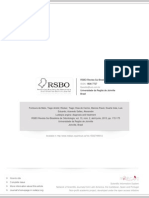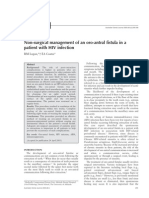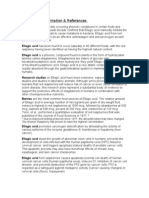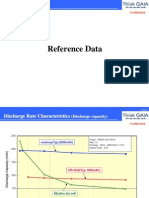Ludwig's Angina - An Emergency: A Case Report With Literature Review
Ludwig's Angina - An Emergency: A Case Report With Literature Review
Uploaded by
Zulfahmi NurdinCopyright:
Available Formats
Ludwig's Angina - An Emergency: A Case Report With Literature Review
Ludwig's Angina - An Emergency: A Case Report With Literature Review
Uploaded by
Zulfahmi NurdinOriginal Title
Copyright
Available Formats
Share this document
Did you find this document useful?
Is this content inappropriate?
Copyright:
Available Formats
Ludwig's Angina - An Emergency: A Case Report With Literature Review
Ludwig's Angina - An Emergency: A Case Report With Literature Review
Uploaded by
Zulfahmi NurdinCopyright:
Available Formats
J Nat Sci Biol Med. 2012 Jul-Dec; 3(2): 206208. doi: 10.4103/0976-9668.
101932 PMCID: PMC3510922 Ludwig's Angina An emergency: A case report with literature review Ramesh Candamourty, Suresh Venkatachalam, M. R. Ramesh Babu,1 and G. Suresh Kumar Department of Oral and Maxillofacial Surgery, Indira Gandhi Institute of Dental Sciences, Mahatma Gandhi Medical College and Research Institute Campus, Pillaiyarkuppam, Pondicherry, India 1Department of Oral and Maxillofacial Surgery, Mahatma Gandhi Post Graduate Institute of Dental Sciences, Pondicherry, India Address for correspondence: Dr. Ramesh Candamourty, Department of Oral and Maxillofacial Surgery, Indira Gandhi Institute of Dental Sciences, Mahatma Gandhi Medical College and Research Institute Campus, Pillaiyarkuppam, Pondicherry 607 402, India. Email: ramesh_candy@rediffmail.com Copyright : Journal of Natural Science, Biology and Medicine This is an open-access article distributed under the terms of the Creative Commons Attribution-Noncommercial-Share Alike 3.0 Unported, which permits unrestricted use, distribution, and reproduction in any medium, provided the original work is properly cited. Abstract Ludwig's angina is a form of severe diffuse cellulitis that presents an acute onset and spreads rapidly, bilaterally affecting the submandibular, sublingual and submental spaces resulting in a state of emergency. Early diagnosis and immediate treatment planning could be a lifesaving procedure. Here we report a case of wide spread odontogenic infection extending to the neck with elevation of the floor of the mouth obstructing the airway which resulted in breathlessness and stridor for which the patient was directed to maintain his airway by elective tracheostomy and subsequent drainage of the potentially involved spaces. Late stages of the disease should be addressed immediately and given special importance towards the maintenance of airway followed by surgical decompression under antibiotic coverage. The appropriate use of parenteral antibiotics, airway protection techniques, and formal surgical drainage of the infection remains the standard protocol of treatment in advanced cases of Ludwig's angina.
Keywords: Ludwig's angina, odontogenic infection, surgical decompression, tracheostomy INTRODUCTION
Ludwig's angina was coined after the German physician, Wilhelm Friedrich von Ludwig who first described this condition in 1836 as a rapidly and frequently fatal progressive gangrenous cellulitis and edema of the soft tissues of the neck and floor of the mouth.[1] With progressive swelling of the soft tissues and elevation and posterior displacement of the tongue, the most life-threatening complication of Ludwig's angina is airway obstruction. Prior to the development of antibiotics, mortality for Ludwig's angina exceeded 50%.[2] As a result of antibiotic therapy, along with improved imaging modalities and surgical techniques, mortality currently averages approximately 8%.[2,3]
In Ludwig's angina, the submandibular space is the primary site of infection.[4] This space is subdivided by the mylohyoid muscle into the sublingual space superiorly and the submaxillary space inferiorly. The majority of cases of Ludwig's angina are odontogenic in etiology, primarily resulting from infections of the second and third molars. The roots of these teeth penetrate the mylohyoid ridge such that any abscess, or dental infection, has direct access to the submaxillary space. Once infection develops, it spreads contiguously to the sublingual space. Infection can also spread contiguously to involve the pharyngomaxillary and retropharyngeal spaces, thereby encircling the airway.
Other causes include peritonsillar or parapharangeal abscesses, mandibular fractures, oral lacerations/piercing or submandibular sialadenitis, and oral malignancy.[5] Predisposing factors include dental caries, recent dental treatment, systemic illness such as diabetes mellitus, malnutrition, alcoholism, compromised immune system such as AIDS and organ transplantation.[69] Without a treatment, it is frequently fatal from the risk of asphyxia with a mortality rate of 50%. The aggressive surgical intervention, the antibiotic introduction, and the improvement of dental care have determined a significant reduction of the mortality rate to less than 10%.[10]
CASE REPORT A 25-year-old gentleman reported to the Department of Oral and Maxillofacial Surgery with a chief complaint of inability to open the mouth, pain, and swelling in relation to the lower jaw and neck since a day. On physical examination, he had respiratory distress and was toxic in appearance and his vital signs were monitored immediately. His temperature was 101.8F with a pulse rate of 106 beats per minute, blood pressure of 140/90 mmHg, and a respiratory rate of 25 breaths per minute. Mouth opening was limited to 1.5 cm (interincisal distance) and revealed grossly decayed lower right second molar tooth with drainage of pus. Extra-oral swelling was indurated, nonfluctuant with bilateral involvement of the submandibular and sublingual glands [Figure 1]. An immediate diagnosis of Ludwig's angina was made, and the patient was posted for surgical decompression under general anesthesia. However, elective tracheostomy was planned for airway maintenance with the help of an otolaryngologist. The
blood report was normal except for raise in ESR, eosinophilia. Elective tracheostomy was done under local anesthesia, airway secured and general anesthesia was provided. Separate stab incisions was made in relation to the submandibular space bilaterally and submental space. A sinus forceps was introduced to open up the tissue spaces and pus was drained. The wound was irrigated with normal saline, and a separate tube drain was placed and secured to the skin with silk sutures [Figure 2]. Intravenous administration of cefotaxime 1 g Bd, gentamycin 80 mg Bd, metrogyl 500 mg, Tid were given for 5 days with a tapering dose of decadran 84 mg Bd for first two postoperative days. Postoperative irrigation was done through the drain which was removed after 36 h along with the infected tooth. Tracheostomy tube care was taken in the postoperative period, and the skin was strapped on the fifth postoperative day after the removal of the tracheostomy tube. Patient recovery was satisfactory.
DISCUSSION Ludwig's angina and deep neck infections are dangerous because of their normal tendency to cause edema, distortion, and obstruction of airway and may arise as a consequence of airway management mishaps. In the early stages of the disease, patients may be managed with observation and intravenous antibiotics. Advanced infections require the airway to be secured with surgical drainage. This is complicated by pain, trismus, airway edema, and tongue displacement creating a compromised airway.
-hemolytic streptococcus associated with anaerobic germs such as peptostreptococcus and pigmented bacteroides have been described as causative agents. Streptococcus viridans (40.9%), Staphylococcus aureus (27.3%), and Staphylococcus epidermis (22.7%) were isolated from deep neck infections. Intravenous penicillin G, clindamycin or metronidazole are the antibiotics recommended for use prior to obtaining culture and antibiogram results. Some authors also recommend the association of gentamycin.[11,12] Recent case reports advocated the use of intravenous steroids which potentially avoided the need for airway management.[1,4]
If patients present with swelling, pain, elevation of the tongue, malaise, fever, neck swelling, and dysphagia, the submandibular area can be indurated, sometimes with palpable crepitus. Inability to swallow saliva and stridor raise concern because of imminent airway compromise. The most feared complication is airway obstruction due to elevation and posterior displacement of the tongue.[3] To reduce the risk of spread of infection, needle drainage can be performed.[13]
Airway compromise is always synonymous with the term Ludwig's angina, and it is the leading cause of death. Therefore, airway management is the primary therapeutic concern.[3] The stage of the disease and comorbid conditions at the time of presentation, physician experience, available resources, and personnel are all crucial factors in the decision making.[14] Immediate involvement of an anesthetist and an otolaryngology team is crucial.[15] Blind nasotracheal intubation should not be attempted in patients with Ludwig's angina given the potential for bleeding and abscess rupture.[4,14,15] Flexible nasotracheal intubation requires skill and experience, if not feasible, cricothyrotomy and tracheostomy under local anesthesia are occasionally performed in the emergency department in those with advanced stages of the disease.[16] Elective awake tracheostomy is a safer and more logical method of airway management in patients with a fully developed Ludwig's angina.[17]
Tracheostomy using local anesthesia has been considered the gold standard of airway management in patients with deep neck infections, but it may be difficult or impossible in advanced cases of infection because of the position needed for tracheostomy or because of anatomical distortion of the anterior neck.[1820]
Footnotes Source of Support: Nil.
Conflict of Interest: None declared.
REFERENCES 1. Saifeldeen K, Evans R. Ludwig's angina. Emerg Med J. 2004;21:2423. [PMCID: PMC1726306] [PubMed: 14988363] 2. Bansal A, Miskoff J, Lis RJ. Otolaryngologic critical care. Crit Care Clin. 2003;19:5572. [PubMed: 12688577] 3. Moreland LW, Corey J, McKenzie R. Ludwig's angina. Report of a case and review of the literature. Arch Intern Med. 1988;148:4616. [PubMed: 3277567] 4. Spitalnic SJ, Sucov A. Ludwig's angina: Case report and review. J Emerg Med. 1995;13:499503. [PubMed: 7594369] 5. Fischmann GE, Graham BS. Ludwig's angina resulting from the infection of an oral malignancy. J Oral Maxillofac Surg. 1985;43:7956. [PubMed: 3862779] 6. Owens BM, Schuman NJ. Ludwig's angina. Gen Dent. 1994;42:847. [PubMed: 8005408]
7. Owens BM, Schuman NJ. Ludwig's angina: Historical perspective. J Tenn Dent Assoc. 1993;73:1921. [PubMed: 8474245] 8. LeJeune HB, Amedee RG. A review of odontogenic infections. J La State Med Soc. 1994;146:23941. [PubMed: 8057047] 9. Finch RG, Snider GE, Jr, Sprinkle PM. Ludwig's angina. JAMA. 1980;243:11713. [PubMed: 7359670] 10. Britt JC, Josephson GD, Gross CW. Ludwig's angina in the pediatric population: Report of a case and review of the literature. Int J Pediatr Otorhinolaryngol. 2000;52:7987. [PubMed: 10699244] 11. Har-El G, Aroesty JH, Shaha A, Lucente FE. Changing trends in deep neck abscess. A retrospective study of 110 patients. Oral Surg Oral Med Oral Pathol. 1994;77:44650. [PubMed: 8028865] 12. Kurien M, Mathew J, Job A, Zachariah N. Ludwig's angina. Clin Otolaryngol Allied Sci. 1997;22:2635. [PubMed: 9222634] 13. Bross-Soriano D, Arrieta_Gmez JR, Prado-Calleros H, Schimelmitz-ldi J, Jorba-Basave S. Management of Ludwig's angina with small neck incisions: 18 years experience. Otolaryngol Head Neck Surg. 2004;130:7127. [PubMed: 15195057] 14. Shockley WW. Ludwig's angina: A review of current airway management. Arch Otolaryngol Head Neck Surg. 1999;125:600. [PubMed: 10326825] 15. Marple BF. Ludwig's angina: A review of current airway management. Arch Otolaryngol Head Neck Surg. 1999;125:5969. [PubMed: 10326823] 16. Neff SP, Merry AF, Anderson B. Airway management in Ludwig's angina. Anaesth Intensive Care. 1999;27:65961. [PubMed: 10631426] 17. Parhiscar A, Har-El G. Deep neck abscess: A retrospective study of 210 cases. Ann Otol Rhinol Laryngol. 2001;110:10514. [PubMed: 11713917] 18. Irani BS, Martin-Hirsch D, Lannigan F. Infection of the neck spaces: A present day complication. J Laryngol Otol. 1992;106:4558. [PubMed: 1613380] 19. Sethi DS, Stanley RE. Deep neck abscesses changing trends. J Laryngol Otol. 1994;108:13843. [PubMed: 8163915] 20. Busch RF, Shah D. Ludwig's angina: Improved treatment. Otolaryngol Head Neck Surg. 1997;117:S1725. [PubMed: 9419139] Figures and Tables Figure 1
Preoperative appearance with bilateral involvement of the submandibular, sublingual, and the submental spaces showing brawny induration of the swelling
Figure 2
Postoperative view showing the tube drains and tracheostomy tube in place
You might also like
- Gait Phases Kinetics Kinema TicsDocument36 pagesGait Phases Kinetics Kinema Ticsjonrocks100% (1)
- JNSBM 3 206Document3 pagesJNSBM 3 206Enika Natalia Christi TilaarNo ratings yet
- Ludwig Sang in ADocument4 pagesLudwig Sang in AnabillaNo ratings yet
- Presented By:-Dr. Saqib Majeed Salik Resident Maxillofacial Supervised By: - Dr. Suad A Ahmad Consultant Maxillofacial King Abdullah Hospital BishaDocument53 pagesPresented By:-Dr. Saqib Majeed Salik Resident Maxillofacial Supervised By: - Dr. Suad A Ahmad Consultant Maxillofacial King Abdullah Hospital BishaSaqib Majeed SalikNo ratings yet
- Angina LudwigDocument4 pagesAngina LudwigArri KurniawanNo ratings yet
- Ludwig 'S Angina: Clinical ImagesDocument2 pagesLudwig 'S Angina: Clinical Images송란다No ratings yet
- Emergency Medicine:: Pediatric Deep Neck Space Abscesses: A Prospective Observational StudyDocument6 pagesEmergency Medicine:: Pediatric Deep Neck Space Abscesses: A Prospective Observational StudyG Virucha Meivila IINo ratings yet
- Ludwig (42 - TD$DIFF) 'S Angina: A Case Report With A 5-Year Follow-UpDocument6 pagesLudwig (42 - TD$DIFF) 'S Angina: A Case Report With A 5-Year Follow-Upshargunan11No ratings yet
- Ludwig AnginaDocument5 pagesLudwig AnginaSiti Aprilia wahyuniNo ratings yet
- Jced 9 E319Document6 pagesJced 9 E319sorayahyuraNo ratings yet
- Case Report Ludwigs AnginaDocument4 pagesCase Report Ludwigs AnginaErma GusmayantiNo ratings yet
- March 2015 266-269 PDFDocument4 pagesMarch 2015 266-269 PDFEsha PradnyanaNo ratings yet
- Submandibular Space Infection: A Potentially Lethal InfectionDocument7 pagesSubmandibular Space Infection: A Potentially Lethal InfectionAnonymous 9KcGpvNo ratings yet
- Murray A.d., Meyers A.D. Deep Neck Infections. Otolaryngology and Facial Plastic SurgeryDocument17 pagesMurray A.d., Meyers A.D. Deep Neck Infections. Otolaryngology and Facial Plastic SurgeryAndi Karwana CiptaNo ratings yet
- Jurnal Reading: Ludwig's AnginaDocument14 pagesJurnal Reading: Ludwig's AnginaNoritaAprilyaSiswandeviNo ratings yet
- Abses SubmentalDocument11 pagesAbses SubmentalSilviaSumintoNo ratings yet
- Angina Ludwig PDFDocument7 pagesAngina Ludwig PDFAgus KarsetiyonoNo ratings yet
- Transorbital Endotracheal Intubation:a Nonstandard Approach To A Difficult AirwayDocument4 pagesTransorbital Endotracheal Intubation:a Nonstandard Approach To A Difficult AirwayAnonymous TbAF2dLyCNo ratings yet
- J Clin Exp Dent-AHEAD OF PRINT Severe Odontogenic Infection Severe Odontogenic Infection: An Emergency. Case ReportDocument7 pagesJ Clin Exp Dent-AHEAD OF PRINT Severe Odontogenic Infection Severe Odontogenic Infection: An Emergency. Case ReportdwilestarimayamNo ratings yet
- Pi Is 0002817714647723Document6 pagesPi Is 0002817714647723Deka Dharma PutraNo ratings yet
- EsofagoDocument6 pagesEsofagoWillie VanegasNo ratings yet
- CASE REPORT - Drainage of Ludwig's Angina in A Pregnant Patient Under Superficial Cervical Plexus BlockDocument4 pagesCASE REPORT - Drainage of Ludwig's Angina in A Pregnant Patient Under Superficial Cervical Plexus BlockIna Permata DewiNo ratings yet
- Emergency Management of Ludwig's Angina: A Case Report: Nur H. Alimin, Endang SyamsuddinDocument4 pagesEmergency Management of Ludwig's Angina: A Case Report: Nur H. Alimin, Endang Syamsuddin송란다No ratings yet
- 15 Submandibular Space Infection A Potentially Lethal Infection PDFDocument8 pages15 Submandibular Space Infection A Potentially Lethal Infection PDFAhmad Rifqi RizalNo ratings yet
- Ludwigs Angina A Case Report Jimds 1000126Document4 pagesLudwigs Angina A Case Report Jimds 1000126Anonymous 2BC7omLaWCNo ratings yet
- GJHS 6 221Document5 pagesGJHS 6 221Teuku FaisalNo ratings yet
- Pi Is 2090074012000357Document6 pagesPi Is 2090074012000357Diggi VioNo ratings yet
- Clinical Survey For Ludwig's Angina Cases Presented in The Emergency Department of Al-Salam Teaching HospitalDocument6 pagesClinical Survey For Ludwig's Angina Cases Presented in The Emergency Department of Al-Salam Teaching HospitalScivision PublishersNo ratings yet
- Severe Odontogenic InfectionsDocument8 pagesSevere Odontogenic InfectionsmumunooNo ratings yet
- Oropharyngeal Candidiasis: Review of Its Clinical Spectrum and Current TherapiesDocument18 pagesOropharyngeal Candidiasis: Review of Its Clinical Spectrum and Current TherapiesDelbert GradyNo ratings yet
- AANA Journal Course: Update For Nurse Anesthetists Ludwig Angina: Forewarned Is ForearmedDocument7 pagesAANA Journal Course: Update For Nurse Anesthetists Ludwig Angina: Forewarned Is ForearmedTyo RizkyNo ratings yet
- Contin Educ Anaesth Crit Care Pain-2012-Morosan-bjaceaccp-mks031Document6 pagesContin Educ Anaesth Crit Care Pain-2012-Morosan-bjaceaccp-mks031Anonymous S0H8cqgnfiNo ratings yet
- Dentoalveolar InfectionsDocument10 pagesDentoalveolar InfectionsCristopher Alexander Herrera QuevedoNo ratings yet
- Surgical Management of Parapharyngeal AbscessDocument3 pagesSurgical Management of Parapharyngeal AbscessmeyNo ratings yet
- Gradenigo Syndrome From Acute Sphenoiditis: A Case: OtolaryngologyDocument4 pagesGradenigo Syndrome From Acute Sphenoiditis: A Case: OtolaryngologymitaNo ratings yet
- Ludwig 2 PDFDocument4 pagesLudwig 2 PDFWidyastuti RenaningsihNo ratings yet
- Medicina 58 01758Document8 pagesMedicina 58 01758charlaayasyafefiNo ratings yet
- Malignant Otitis Externa in Patients With Diabetes Mellitus: Case ReportDocument0 pagesMalignant Otitis Externa in Patients With Diabetes Mellitus: Case ReportSuci PramadianiNo ratings yet
- Ludwig AnginaDocument3 pagesLudwig AnginaWellyAnggaraniNo ratings yet
- NAMJ Case Report: Aerodigestive Foreign BodyDocument12 pagesNAMJ Case Report: Aerodigestive Foreign BodyBelanny DwiNo ratings yet
- Ludwig AnginaDocument7 pagesLudwig AnginaCak BasitNo ratings yet
- Ludwigs Angina Diagnosis and TreatmentDocument5 pagesLudwigs Angina Diagnosis and TreatmentfaizkanwarNo ratings yet
- Ludwig'S Angina: A Case With A 5-Year Follow-Up: SciencedirectDocument6 pagesLudwig'S Angina: A Case With A 5-Year Follow-Up: SciencedirectnurfitriaNo ratings yet
- Krespi 1997Document4 pagesKrespi 1997kwpang1No ratings yet
- Oroantral FistulaDocument4 pagesOroantral FistulaMahesh AgrawalNo ratings yet
- ID Angina Ludwig Pada Pasien Laki Laki DewaDocument5 pagesID Angina Ludwig Pada Pasien Laki Laki Dewanana kunaNo ratings yet
- ADJ-odontogenic InfectionDocument9 pagesADJ-odontogenic Infectiondr.chidambra.kapoorNo ratings yet
- Ear Nose and Throat Emergencies and Anesthesia PDFDocument7 pagesEar Nose and Throat Emergencies and Anesthesia PDFAnizha AdriyaniNo ratings yet
- 473 1255 1 PBDocument13 pages473 1255 1 PBPeter SalimNo ratings yet
- An Institutional Study On Covid-19 Associated Rhino-Orbital-Cerebral MucormycosisDocument8 pagesAn Institutional Study On Covid-19 Associated Rhino-Orbital-Cerebral MucormycosisIJAR JOURNALNo ratings yet
- Around The Posterior Margin of The Mylohyoid MuscleDocument8 pagesAround The Posterior Margin of The Mylohyoid MuscleTyo RizkyNo ratings yet
- Estenosis Suoerior enDocument38 pagesEstenosis Suoerior enJosé GómezNo ratings yet
- Abses SeptumDocument3 pagesAbses SeptumwitariNo ratings yet
- Surgical Management of Parapharyngeal Space InfectionsDocument16 pagesSurgical Management of Parapharyngeal Space InfectionsAndrés Faúndez TeránNo ratings yet
- Acute Epiglottitis: Trends, Diagnosis and Management: Claude AbdallahDocument3 pagesAcute Epiglottitis: Trends, Diagnosis and Management: Claude AbdallahDwi Ayu PrimadanaNo ratings yet
- Tonsilitis IndiaDocument2 pagesTonsilitis IndiaQonita Aizati QomaruddinNo ratings yet
- Fatal Airway Obstruction Due To Ludwig'sDocument6 pagesFatal Airway Obstruction Due To Ludwig'sRegina MugopalNo ratings yet
- Infections of the Ears, Nose, Throat, and SinusesFrom EverandInfections of the Ears, Nose, Throat, and SinusesMarlene L. DurandNo ratings yet
- 4gauging GTXDocument1 page4gauging GTXZulfahmi NurdinNo ratings yet
- Oral PigmentedDocument16 pagesOral PigmentedZulfahmi NurdinNo ratings yet
- Tumor Jinak Rongga MulutDocument4 pagesTumor Jinak Rongga MulutZulfahmi NurdinNo ratings yet
- Brochure-Gc Fuji ViiDocument16 pagesBrochure-Gc Fuji ViiZulfahmi NurdinNo ratings yet
- SonicFill Handpiece Instructions For UseDocument58 pagesSonicFill Handpiece Instructions For UseZulfahmi NurdinNo ratings yet
- SonicFill 2 Technique GuideDocument1 pageSonicFill 2 Technique GuideZulfahmi NurdinNo ratings yet
- Indications and Case Series of Intentional Replantation of TeethDocument8 pagesIndications and Case Series of Intentional Replantation of TeethZulfahmi NurdinNo ratings yet
- Ellagic Acid Information & ReferencesDocument6 pagesEllagic Acid Information & ReferencesZulfahmi NurdinNo ratings yet
- Effect of Refrigeration On Bond Strength of Self-Etching Adhesive SystemsDocument5 pagesEffect of Refrigeration On Bond Strength of Self-Etching Adhesive SystemsZulfahmi NurdinNo ratings yet
- Dentj 39 2 04Document4 pagesDentj 39 2 04Zulfahmi NurdinNo ratings yet
- Cariesactivitytests 090722115427 Phpapp01Document14 pagesCariesactivitytests 090722115427 Phpapp01Zulfahmi NurdinNo ratings yet
- Discharge Characteristics 3UQDocument5 pagesDischarge Characteristics 3UQZulfahmi NurdinNo ratings yet
- A Pervert's World 251,,300Document168 pagesA Pervert's World 251,,300venushkafdoNo ratings yet
- GRP5 Fur Fect Match Final SIGNEDDocument150 pagesGRP5 Fur Fect Match Final SIGNEDJaezar Philip Francisco GragasinNo ratings yet
- Structure Part B: Error With PronounDocument16 pagesStructure Part B: Error With PronounDelia RasmawatiNo ratings yet
- How To Draw A Reindeer - Easy Drawing ArtDocument13 pagesHow To Draw A Reindeer - Easy Drawing Artcount ossieNo ratings yet
- INAPHDocument4 pagesINAPHSri VasuNo ratings yet
- PW Trail Beaver Valley Oct18Document56 pagesPW Trail Beaver Valley Oct18Pennywise PublishingNo ratings yet
- Koding Dengan Icd-ODocument69 pagesKoding Dengan Icd-OANGGUNNo ratings yet
- Milking ProceduresDocument3 pagesMilking ProceduresCristina Carvalho100% (1)
- Coding - Decoding For OmetsDocument11 pagesCoding - Decoding For OmetsRamakrishna MaityNo ratings yet
- 1.2.Đề Nghe-đọc-Viết Lđt 2020Document15 pages1.2.Đề Nghe-đọc-Viết Lđt 2020Huỳnh Ngan AnhNo ratings yet
- Marrow 1: Examining Shakespeare Through A Cryptozoological LensDocument15 pagesMarrow 1: Examining Shakespeare Through A Cryptozoological LensMackenzie MarrowNo ratings yet
- Vertebrates: Fishes Amphibians Reptiles Birds MammalsDocument8 pagesVertebrates: Fishes Amphibians Reptiles Birds Mammalsf1940003No ratings yet
- Rhetorical Analysis EssayDocument6 pagesRhetorical Analysis EssayTori ThomasNo ratings yet
- شريف الهوارى ساينس رابعة ترم اول نهائىDocument9 pagesشريف الهوارى ساينس رابعة ترم اول نهائىMohamed HamedNo ratings yet
- The Essential Guide To Dim Mak Pressure PointsDocument19 pagesThe Essential Guide To Dim Mak Pressure Pointsscarface100% (2)
- The Veterinary Laboratory & Field Manual: 2nd EditionDocument1 pageThe Veterinary Laboratory & Field Manual: 2nd EditionFrontiersNo ratings yet
- (Ngulang LG) Simulation 1 Tugas B, Ing TGL 17-03-2021Document10 pages(Ngulang LG) Simulation 1 Tugas B, Ing TGL 17-03-2021Muhammad Aldino Rizky X IPA 4No ratings yet
- 522 - Adjectives Test Exercises Multiple Choice Questions With Answers Advanced Level 23Document6 pages522 - Adjectives Test Exercises Multiple Choice Questions With Answers Advanced Level 23Juan Carlos Hernandez Muñoz - DocenteNo ratings yet
- Nouns in English GrammarDocument3 pagesNouns in English GrammarTereza Emanuella Menezes SantosNo ratings yet
- Ostomy Care in Home Health1Document39 pagesOstomy Care in Home Health1api-315120220100% (1)
- Canine WorkbookDocument48 pagesCanine Workbookrosy_verenice100% (1)
- Grammar For A2+readingDocument14 pagesGrammar For A2+readingGüray KanselNo ratings yet
- Sample Answer:: Mark SchemeDocument4 pagesSample Answer:: Mark SchemeKatherinaNo ratings yet
- Free Classifieds: in Pakistan Start Your Own Profitable Business of Batair (Quails) and Ducks FarmingDocument33 pagesFree Classifieds: in Pakistan Start Your Own Profitable Business of Batair (Quails) and Ducks FarmingShahzad Rao NoorNo ratings yet
- Goddess DurgaDocument6 pagesGoddess DurgaanjalibhatsNo ratings yet
- Sea of Slaughter Mowat 1984Document423 pagesSea of Slaughter Mowat 1984_thoranNo ratings yet
- Delhi Public School, Bopal, Ahmedabad Class: X Biology Assignment Chapter: Life Processes (Respiration)Document2 pagesDelhi Public School, Bopal, Ahmedabad Class: X Biology Assignment Chapter: Life Processes (Respiration)Aaryan PanchalNo ratings yet
- EDS Multiple Choice QuestionsDocument4 pagesEDS Multiple Choice QuestionsbalochimrankhanNo ratings yet
- Science Form 2 Chapter 1Document18 pagesScience Form 2 Chapter 1Nor Fadhilah ZainudinNo ratings yet





































































































